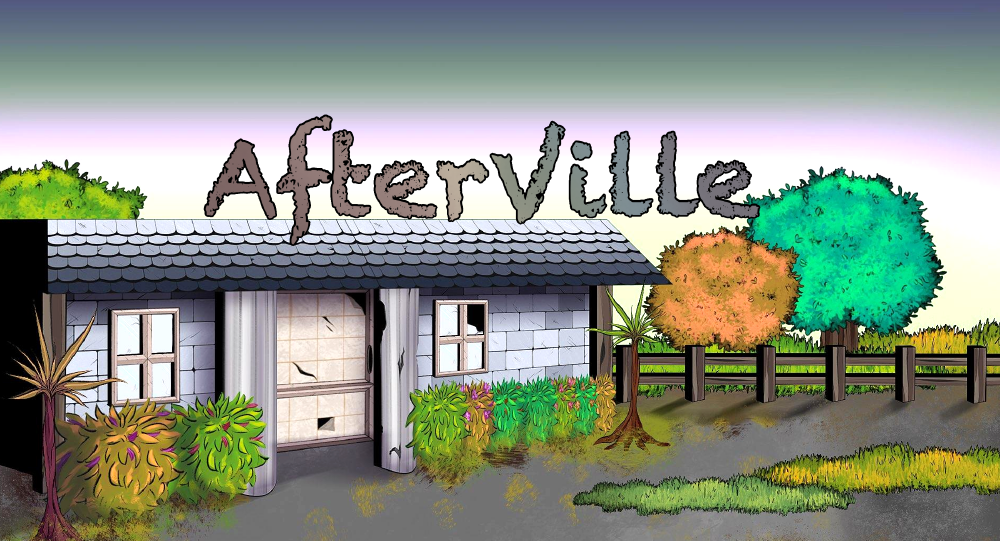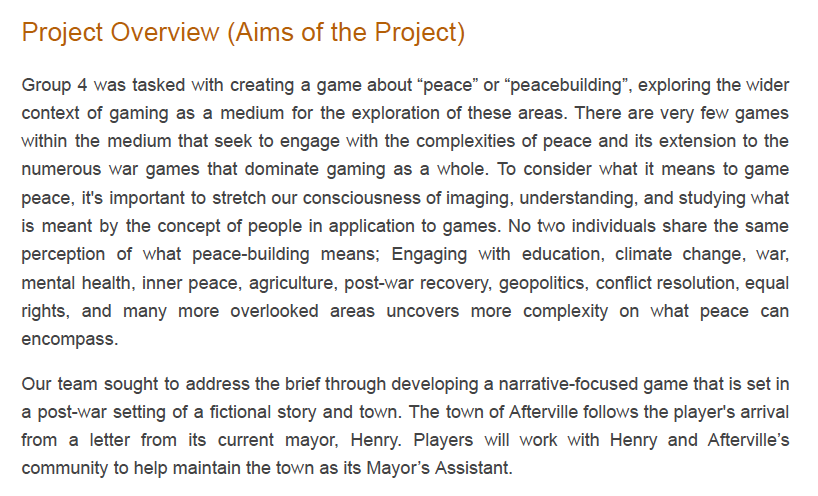In 2023, our Visualising Peace team collaborated with a team of students studying game design through Abertay University’s MPROF programme, to explore the challenges and opportunities of designing and marketing an online game about peace and peace-building.

Brief
The brief which the Visualising Peace team gave to our partners at Abertay was as follows:
We would like the game you design to (1) deepen understanding of and (2) nurture skills for PEACE-BUILDING. This might be peace-building at an international level, or peace-building in more local settings.
In terms of deepening understanding: we are keen to move players beyond the idea that peace-building simply involves a ceasefire or the signing of a treaty, and we want to expand understanding of the many different people who can and should be involved in peace-building, including marginalised voices, women and even children. Key words that we associate with peace-building are: long-term, hard work, grassroots, bottom-up, collaborative, inclusive. Sustainable peace-building involves paying attention to post-conflict justice, social justice, human rights, equality. Peace-building is often imperfect, fragile, challenging, unsatisfying. Peace-building can sometimes even be disruptive, violent, revolutionary. Sustainable peace-building requires a lot of time and funding/resource – but it is still much cheaper than war!
In terms of developing skills, the following are very important in sustainable peace-building: listening, open-mindedness, responsible debate, finding common purpose, collaboration, mediation, reconciliation, forgiveness, futures-thinking, future strategizing. Individuals can contribute to peace-building in their own communities by addressing toxic/polarising rhetoric, by countering racism, misogyny and other hate speech/hate behaviour, by building connections across social/ethnic/religious/political/cultural divides. Mindfulness and attention to inner peace can be an important foundation for spreading peace in the wider community, and even in building geopolitical peace; we are also very interested in the role of love, care and compassion. Peace-building also involves developing skills to work co-operatively on major social, political and environmental issues such as climate change, poverty and forced migration.
We have set out these key words/ideas to give you a sense of the aspects of peace-building that we are particularly interested in; but we realise that only a few of these aspects can be built into a single game. If we had to highlight just five, we would pick the following key words/phrases: collaborative/co-operative, inclusive, caring, sustainable in the long term, but also imperfect.

Over a period of three months, we worked closely our Abertay colleagues as they brought their design skills to realise our vision. The game which they came up with – called Afterville – was set in a small (unspecified) town, around one year after the end of a wider war in the region. Players are invited to become an ‘assistant’ to the town’s mayor, as they process lots of different suggestions from a range of local inhabitants to promote post-conflict recovery and peace-building. One challenge is balancing the budget, and participants become experienced not just in weighing up the financial costs of different initiatives but in thinking through their long-term effectiveness and impact on different parts of the demographic. In the course of the game, players meet a wide cast of characters – from a teenager who has lost his father and dropped out of school as a result of the war, to a female veteran with PTSD, to an elderly resident who is struggling to access healthcare, to local farmers and traders whose businesses are struggling, the local bar manager, and the town’s main religious leader. All of these characters have their own priorities and visions for effective peace-building, and players must balance different needs and expectations (from proposals for de-mining and a new playground to new trading initiatives and the construction of a wind farm) as they advise the mayor. Built into the game is a ‘stamina’ gauge, to recognise the emotional toll which such peace-building can take on those involved and the importance of ‘topping up’ and nurturing inner peace at the same time working towards post-conflict recovery and community peace. As players explore the game, they learn valuable lessons about the challenges and compromises involved in sustainable peace-building, and their understanding of what peace means to different people is deepened in the process.
The proto-type game is not yet ready for sharing, but we hope to feature it soon in our virtual Museum of Peace. We are extremely grateful to our Abertay colleagues (and their module leader, Joseph De Lappe) for working with us on this project. Their careful listening and thoughtful responses to our ideas have resulted in a fascinating output, and we have learnt a lot in the process about game design and gaming peace.
Two Visualising Peace students worked particularly closely with the Abertay team: Shengyuan Ji and Isabel Frasier. You can explore some of their related research on digital peace/AI/gaming peace via the following links, plus a museum entry on the topic:
- Gaming and Bilingualism in Peace Education – Shengyuan Ji
- Navigating AI in Peacebuilding, Conflict Resolution and Restorative Justice – Isabel Frasier
- Journey: visualising peace through gaming – Zoe du Bois
